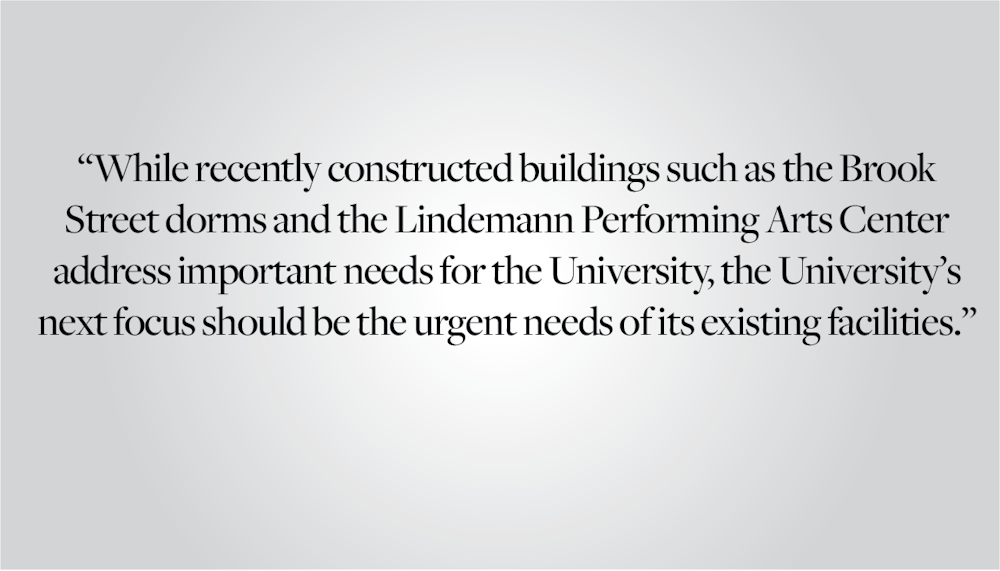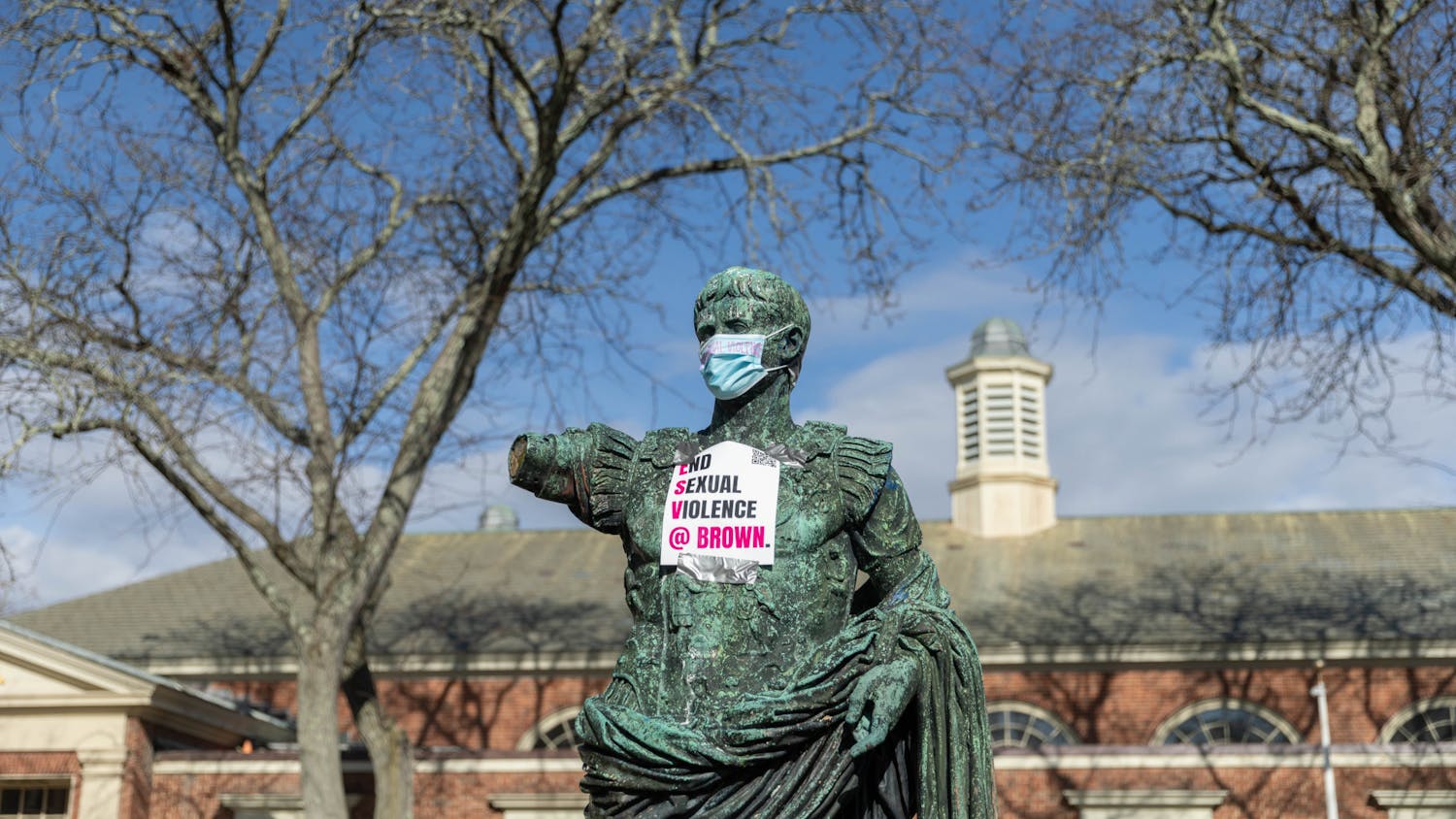Brown has a that make its campus one of the country’s most beautiful. This does not come without a cost: These buildings require intensive maintenance that cannot be deferred without serious consequences. Even a century ago, this issue was well , when buildings like Robinson Hall were already in “poor condition,” per a 1928 report from the superintendent of grounds and buildings. However, in the past few years, the Sternlicht Commons and the Health and Wellness Center, popularly known as the Wellness Dorm, the Lindemann Performing Arts Center and the Brook Street residence halls. The University has also completed a handful of high-profile renovation projects in the last decade, such as and , but there is more work to be done. Today, the issue of buildings unprepared for extreme weather looks increasingly likely to come to a head as dorms begin to show a critical need for major repairs.
For the second year in a row, students have watched helplessly as water floods their dorms and, for some, ruins their possessions. Last semester in Keeney Quadrangle, summer storms led to the evacuation of first-year students only weeks after arriving at Brown. This was deeply disruptive for the first-years and a poor way to introduce them to Brown’s campus experience. This issue has not been limited to summer storms though, and last year saw flooding in Diman House as freezing weather ruptured pipes in the basement. Thankfully, no students were directly affected by this flood, but both of these incidents demonstrate that there are plenty of Brown facilities in need of improvements.
The University cannot put off renovations any longer: Climate change is increasing the severity of and , putting more strain on buildings. So, while a winter storm last year may have only been severe enough to affect one unlucky dorm‚Äôs pipes, storms in coming years may cause more widespread damage. As if this issue was not obvious already, last weekend‚Äôs temperatures below 0 degrees demonstrated how severe these cold snaps can get. The same can be said for summer flooding ‚Äî¬Ý more intense summer storms without any building retrofitting could lead to permanent damage.
While recently constructed buildings such as the Brook Street dorms and the Lindemann Performing Arts Center address important needs for the University, the University’s next focus should be the urgent needs of its existing facilities. While it goes without saying that the University must provide adequate shelter in both its new and old dorms to protect its students from storms, they have additional incentives to make this their top priority.
The new construction Brown has engaged in serves two purposes for the University. Of course, the projects address campus needs, especially student housing, but they also elevate Brown’s profile and keep it competitive with other top-flight institutions across the country. Prospective applicants to Brown can read about the unfinished or scope out a on Brook Street. Schools across the country are in a sort of to provide the best facilities for their students, so the University is smart to exhibit its freshly finished facilities.
Unfortunately for Brown, prospective applicants don’t only hear about shiny new buildings. The Keeney flood in outlets, and prospective applicants are likely to find these articles and consider the quality of Brown’s housing when deciding whether to apply. As more intense storms lead to more severe impacts on student housing, the wider stories of Brown’s lackluster facilities will spread. It is possible that without serious interventions, this could become a well-known issue with Brown’s residential experience, overshadowing the University's important new facilities. By prioritizing retrofits of existing dorms for a period of time, Brown can demonstrate its commitments to the student experience and climate resiliency, the latter of which students find especially in their schools. Rather than letting its buildings be a negative mark, Brown can use this opportunity to become a national leader in updating historical buildings, setting the University above its peer institutions, and attracting positive attention from across the country.
Brown should pursue this opportunity with the same vigor that it has shown in its construction of new buildings. Brown raised through a bond, primarily for the construction of the new Brook Street dorms. One can only imagine how far the University could go with that same total wholly dedicated to retrofitting its existing housing supply. Perhaps a savvy administrator could field large sums from alums who remember their time in the same dorms, mitigating the costs of making these changes. Since 2012, Harvard has led a similar campaign for which has drawn hundreds of millions of dollars in donations ‚Äî albeit not without .¬Ý Though new buildings would likely than dorm retrofitting, it is incumbent upon the University to change the narrative and demonstrate to donors how enhancing existing spaces will benefit students and make the University more competitive.¬Ý
Brown has not announced any new projects on the East Side that will follow the completion of its current projects: It should stay on that course and spend its money ensuring the buildings it already has will last for the that University Hall has. If it does not, it runs a number of risks. It risks damaging student experiences by subjecting them to the impacts of intense storms. It risks sacrificing facilities to disrepair long before their expiration dates, losing the charm of Brown’s campus. Most of all, it risks seriously damaging its reputation. But if Brown shifts its mindset, it can complete some incredible work in ensuring the resiliency of its campus for many years to come.
Gabe Sender ’25 can be reached at gabriel_sender@brown.edu. Please send responses to this opinion to letters@browndailyherald.com and other op-eds to opinions@browndailyherald.com.
Correction: A previous version of this column incorrectly stated that the University received $87.2 million in state funds for the construction of the Brook Street residence halls. In fact, the University issued that amount in bonds through the “quasi-public” , and the funds raised were not intended exclusively for the Brook Street project. The Herald regrets the error.
Gabe Sender is a Staff Columnist at The Brown Daily Herald with a particular focus on campus issues and development challenges in Providence. He is currently pursuing an independent concentration in urban environmentality.




